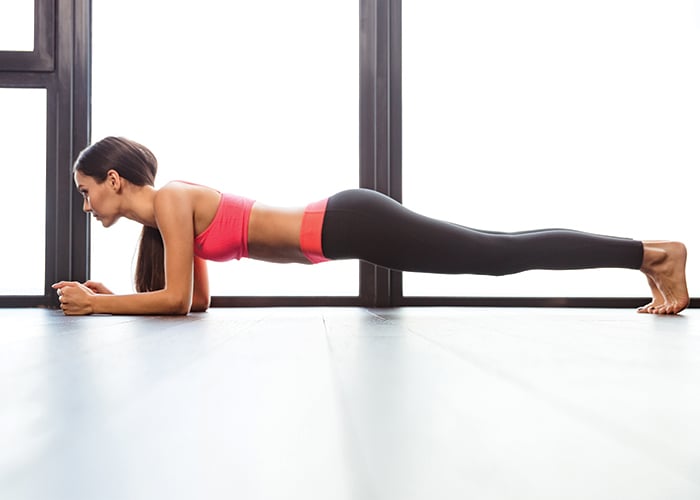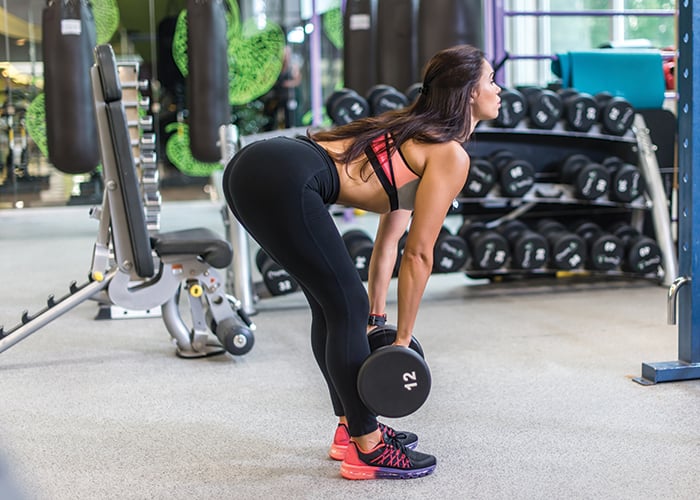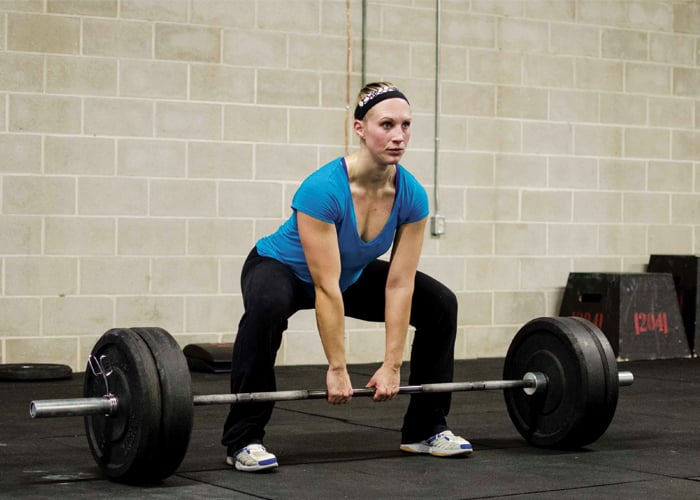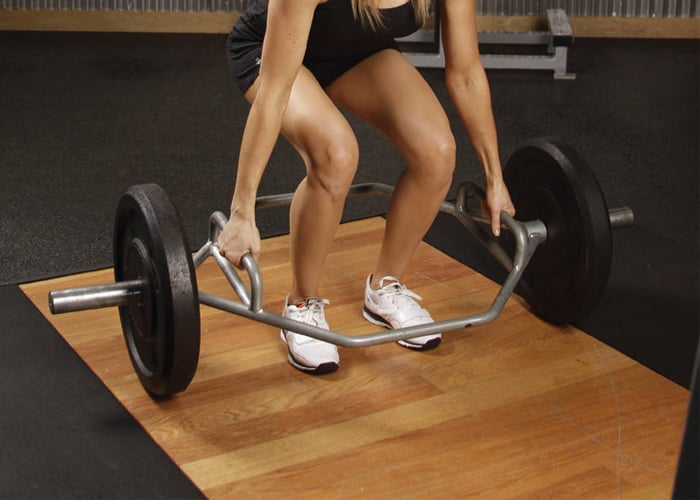Exercise Spotlight : The Deadlift
If you are seeking to train your posterior chain (glutes, hamstrings, and low back), a deadlift workout routine might be for you! The deadlift is probably one of the most challenging lifts to perform correctly! Good form when executing a deadlift involves strength, flexibility, body awareness, and coordination.
Training the deadlift makes your hip and lumbar extensors stronger, which is important in both sports performance and in everyday activities. Hip extension propels us forward in walking and running activities among others (cycling, rowing, etc.). Strong lumbar extensors (i.e. quadratus lumborum and erector spinae muscles) are associated with less low back pain.
A deadlift workout routine is also great exercise to get your heart pumping since it involves so many large muscle groups in your lower extremity! If you’re performing deadlift reps for strength, you’ll likely see a spike in your heart rate for the short duration of your reps, whereas if you’re performing deadlifts for endurance or as part of a circuit, you’re likely to see your heart rate elevated for an extended time.
In this blog post, we are going to review three different types of deadlift variations: the Romanian Deadlift, the Sumo Deadlift, and the Trap Bar Deadlift. We’ll cover how to perform each movement correctly and how to modify and progress each variation.
Before the variations, we’ll highlight three key technical and alignment components required to perform any variation of the deadlift: hip hinge, core engagement, and trunk posture.
- Hip Hinge: The hinge of the deadlift is a critical component. To practice your hip hinge, pretend like you are looking over a cliff with the front of your hips touching a fence lining the edge – you want to keep your weight distributed, but focused back toward your heels –it’s almost as though you are leaning your chest forward over the fence to see over the edge of the cliff.
- Core Engagement: Pull your abdominals up and in to support your back. Really drive your deadlift from your glutes and hamstrings.
- Trunk Posture - Tall Chest: Focus on keeping your chest and shoulders lifted through your entire range of motion. Prevent your upper back and shoulders from rounding by engaging your lats and traps and keeping the weight in close to your body.
Now, on to the variations.
The Romanian Deadlift
This is probably the most common variation of a deadlift workout routine performed. The Romanian Deadlift requires a little more flexibility through your hamstrings and more mobility through your hip joint than the conventional deadlift, as you will have less knee bend in the Romanian Deadlift.
How to Perform:
- Separate your feet about hip-width or a little wider than hip-width apart. Place your feet parallel or slightly turned out.
- Make sure your knees are aligned with your second and third toes.
- If you are starting with the barbell or dumbbells on the ground, keep your chest tall while hinging forward at your hips, press your bottom back slightly, bend your knees softly, and grab onto the barbell or dumbbells about shoulder-width apart or a little more narrow (you can choose an overhand or alternate grip).
- Keep your chest lifted and head and neck in a neutral position.
- Drive through your heels, squeeze your glutes and hamstrings, and start to extend your hips and low back.
- Keep the weight (barbell or dumbbells) close to your body the whole time. Imagine that you are using the weight to shave your legs (but try not to hit your legs – it hurts). This will require you to activate your lats and traps – squeeze your shoulder blades together to keep your chest lifted and the weight close to your body.
- As you reach to top of your extension, drive your hips forward slightly and squeeze your glutes as tight as you can.
- Slowly lower the weight back down toward the floor keeping the weight in close to your body the whole time.
- Lower the weight down as far as your flexibility and mobility will allow you while keeping a tall chest (no rounding of the shoulders).
- Maintain a soft bend in your knees while focusing on the hinge from your hips. Remember: Pretend like you are looking over a cliff with the front of your hips touching a fence.
- Once you have reached the end of your range of motion, drive back up to the top (follow previous instructions).
- Repeat.
How to Modify:
**Please consult a personal trainer to learn the best way to modify or progress your deadlifts to safely meet your individual needs (especially if you are susceptible to back pain or have a low back injury).
- Don’t go as low with the barbell or dumbbells.
- If you do not yet possess the proper form to go all the way to the ground with your deadlift, only go as far as your flexibility and mobility will allow – perhaps you will take the weight just below your knees before extending back up – that’s a great place to start. Focus on form so you can progress without movement compensations (i.e. shoulders rounding forward or moving the weight away from your body).
- Use less weight.
- To really get the technique and form of the deadlift right, start by using a dowel or really light dumbbells.
- Slowly add weight over time while making sure your form is spot on.
- Bend your knees more.
- The more you bend your knees, the less stress on your hamstrings and the less distance between the weight and the end of your range of motion (smaller range of motion). Using a smaller range of motion is a good place to start, and if you have limited flexibility through your hamstrings, slowly progress from more to less knee bend.
How to Progress:
You may progress your deadlift in the following ways:
- Increase the amount of weight you are lifting.
- Increase the speed of the concentric phase of your deadlift (when you come back up).
- Increase your range of motion (take the weight all the way to the floor for each rep).
The Sumo Deadlift
This variation provides more focus through the muscles of your hips (glutes and hamstrings) rather than your lower back. You involve your adductor muscle group (inner thigh muscles) more when using this variation as well. It also shortens the range of motion of the pull, so you can often use more weight when performing this variation; therefore, the sumo deadlift is a good choice when performing deadlifts for strength (fewer reps, more weight).
How to Perform:
- Separate your feet a little wider than shoulder-width apart. Turn your feet out at a 45 degree angle (your knees and your hips will also naturally externally rotate).
- If you are starting with the barbell or dumbbells on the ground, keep your chest tall while hinging forward at your hips, press your bottom back, bend your knees, and grab onto the barbell or dumbbells about shoulder-width apart. An alternate grip is recommended for sumo deadlifts – especially if you are using more weight.
- Keep your chest lifted and head and neck in a neutral position.
- Drive through your heels, squeeze your glutes, hamstrings, and inner thighs and start to extend your hips and low back.
- Keep the weight (barbell or dumbbells) in close to your body the whole time.
- As you reach to top of your extension, drive your hips forward slightly and squeeze your glutes as tight as you can.
- Slowly lower the weight back down toward the floor keeping the weight in close to your body the whole time.
- Lower the weight down as far as your flexibility and mobility will allow you while keeping a tall chest (no rounding of the shoulders).
- Bend your knees while focusing on the hinge from your hips.
- Once you have reached the end of your range of motion, drive back up to the top (follow previous instructions). Typically in a sumo deadlift, you want to try to go all the way to the ground.
- Repeat.
How to Modify:
- Same as Romanian Deadlift
How to Progress:
- Same as Romanian Deadlift
The Trap Bar Deadlift
This is a great variation for targeting your quads a bit more because you will have more knee bend and will be carrying the weight at your sides rather than in front of you. You will absolutely still get glute, hamstring, and low back activation. This is also a nice variation if grip strength is a limiting factor for you – the neutral wrist position and weight distribution of the trap bar make gripping a bit easier.
How to Perform:
- Step inside of the trap bar and separate your feet about hip-width or a little wider than hip-width apart. Place your feet parallel or slightly turned out.
- Make sure your knees are aligned with your second and third toes.
- Keep your chest tall while hinging forward at your hips, press your bottom back slightly, bend your knees, and grab onto the trap bar with a neutral wrist.
- Keep your chest lifted and head and neck in a neutral position.
- Drive through your heels, squeeze your glutes and hamstrings, and start to extend your hips and low back.
- As you reach to top of your extension, drive your hips forward slightly and squeeze your glutes as tight as you can.
- Slowly lower the trap bar down toward the floor.
- Lower the weight down as far as your flexibility and mobility will allow you while keeping a tall chest (no rounding of the shoulders).
- Maintain a bend in your knees while focusing on the hinge from your hips.
- Once you have reached the end of your range of motion, drive back up to the top (follow previous instructions).
- Repeat.
How to Modify:
- Same as Romanian Deadlift
How to Progress:
- Same as Romanian Deadlift
We want to see how you’re including a deadlift workout routine in your workouts! Be sure to post photos or videos of your workouts to Facebook, Instagram, and Twitter using the hashtags #myzonemoves and #effortrewarded so we can see how you’re doing!
For more exercises and tips on using MYZONE in your training, check out our #FitnessFriday Facebook Live broadcasts on the MYZONE Facebook page every Friday at 8 am PT, 11 am ET. You can also tune in to the MYZONE® Moves Podcast on iTunes or Google Play.
Keep Moving Forward!
Share this
You May Also Like
These Related Stories

Low Maintenance Cardio & Muscular Fitness Circuit
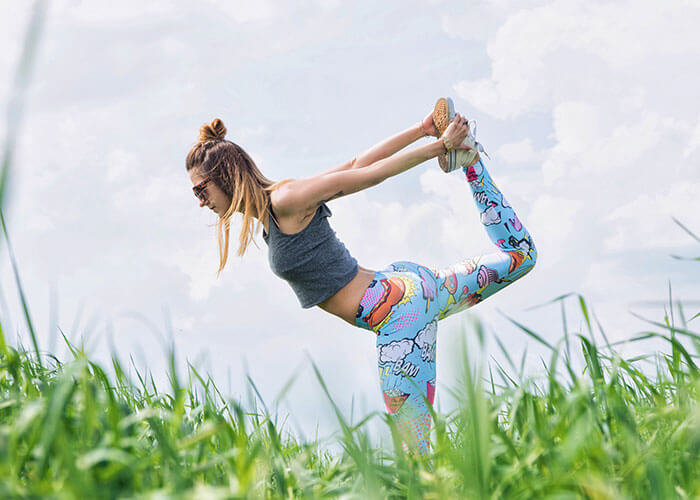
Myzone: What’s Your Workout Mission?
